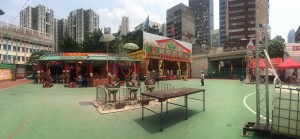As one of the only white foreigners in this program I was really quite happy that I was chosen for a site that embodied the less flashy, touristy, or western oriented districts of Hong Kong. The instructors could easily have given me a suburban or distinctly “safer” site to make my transition into the new culture less of a blinding contrast from my American roots. However, this was not the case and I’m thankful for the site I was given in Tai Kok Tsui. It’s a place with a surface level appearance of being uncomfortable at best and downright insufferable at worst, especially during the day. With it’s lack of trees, oppressive heat, bustling and endless intersections, Tai Kok Tsui is easy to write off as an urban jail cell which holds captive aging residents destined for exhaustion. In the afternoon sun, grandmas line the park benches to escape the heat of their air condition-less apartments, shop owners nap lazily along their storefronts waiting for customers to come through the empty streets, it is a place that begs for relief. This was the view I took on the area within the first minute of stepping off the MTR, but that feeling did not last long. While the district presents a façade of ecological absence and discomfort at times, it’s livability comes from it’s life unseen during much of the day. It’s a place that serves the needs of its people, people who are at work escaping the midday sun, and come home at night to give the community its charismatic vibrancy.

Streets of Tai Kok Tsui
This unseen image of Tai Kok Tsui is what I hoped to express in both the video that my group made and the board we created. Molded by Chinese tradition, Tai Kok Tsui’s people and energy are what created a cultural image that’s now burned in my mind not soon to be forgotten. So how did that translate into a three-minute video? It was my utmost intention not to make a descriptive video about the site with overlaid writing and narration required to give the viewers an understanding of my feelings about being in Tai Kok Tsui. I know other groups did a great job in creating often times humorous videos that gave a straight forward idea of their site’s identity, but I wanted to carefully compose a video that spoke for itself with it’s pace and emotional tone. Much like our board which had a near-scrapbook-like quality about it, detailing our movement through the district, I wanted to make the video a similar account of how we navigated through Tai Kok Tsui without unnecessary formal explanation. With the still panel board presentation, we were a bit clearer about the actual layout of the district with a map showing certain nodes, edges, and landmarks. Since we could be explicit in talking about the detail of our site on the board with elements that effect the physical condition, the short video was a way to visually represent these scenes in motion. We show the idea of nodes, edges, and landmarks from our site during the video in the way they are used throughout the day the same way we explained them from the presentation of our A0 board, but now the viewer can experience them with feeling rather than just as an idea.
In the beginning of the video we start with long, slow, still shots of the empty streets and parks being used mainly for relief. The melancholy music used in the first half of the video describes the pace and struggle of the older generation in the daily heat. We transition into an account of traditional practice as we came across a football court that was being used as grounds for the ghost festival celebration. The orchestral sounds of gongs and other traditional instruments could be heard ringing throughout the blocks as the burning in respect of the dead scented the air. The next scene shows a woman who we interviewed who discussed the area’s difference in time of day, and how people and vendors really become lively at night. Unfortunately, the actual audio didn’t come through on the clip because of the loud street noise and a jackhammer blaring at a neighboring shop. This was our segway into the exuberant night scene we found ourselves in when we revisited Tai Kok Tsui. People overtook alleyways, sidewalks and restaurants with temporary seating for dinner, street vendors sold fresh fruits and produce to businessmen coming back from work, the MTR exit buzzed with people frantically brushing past one another in the tight crowds to return home. We used more dramatic music in this section of the video with quick cuts, freehand shots, and time-lapse footage to create a sense of energy and liveliness. Scenes of people using their space contrasting from similar locations used in the first part of the video were used to show how the way people fill the spaces that surround them is what gives that place an identity. Just because the impression of the day seemed bleak at first, people were still filling the streets with tradition and feelings that if you keep an eye out for, aren’t hard to find. I will not soon forget the culture so alive on those streets, or the scent of incense burning in respect for the dead on every corner, and I can only hope that people get the same sort of understanding of Tai Kok Tsui from the still board presentation and accompanying video my group mates and I created.
Video
Andrew

